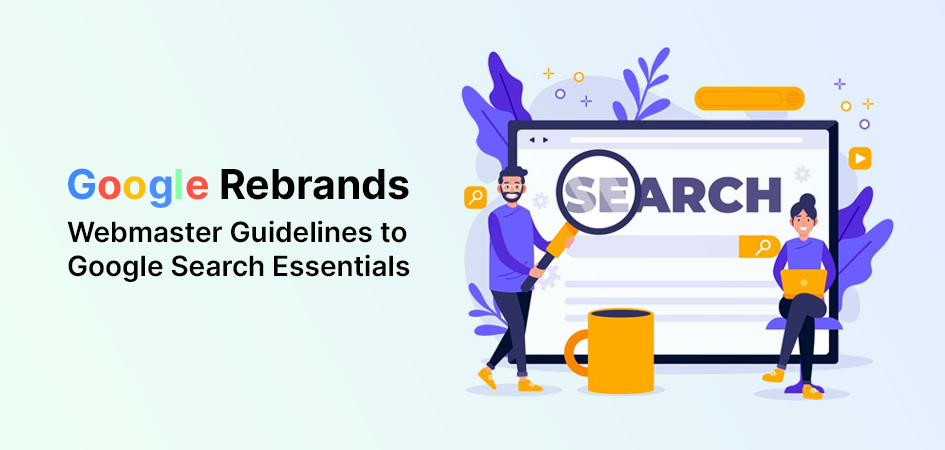
Search engine giant Google has officially rebranded its webmaster guideline, presenting it as Google search essentials.
Apparently, Google wants to depart from the term “webmaster” as it doesn’t include all content creators and it’s a dated term. Google says the tool is not just for webmasters; instead it’s for publishers, site owners, creators, developers, etc.
“For the new name we wanted something generic, something that’s not focusing on just one slice of our visitors, but rather all creators on the internet who wish to see their content in Google Search.” – Google Search Central official release.
Additionally, over the past few years Google has stopped using the term “webmaster” i.e. they changed it from “Google webmaster tool” to “Google search console”.
Furthermore, Google says, they have launched a simplified version of the webmaster guidelines for all. On October 13th, they announced the news and refreshed the webmaster guidelines in a whole new way!
What exactly has changed?
More than just changing the name, Google has changed the format. Google Search Essentials include three simplified categories for easier consumption.
Here are the three categories:
- Technical Requirement
- Key Best Practices
- Spam Policies
We will dig deeper to learn more about the categories in the below section.
Google webmaster’s overall format has changed. The terms are clearer with examples so that every content creator irrespective of their SEO expertise can understand Google Search Central, get first-hand updates on an algorithm, have easier access to community support, and access to the latest events.
Not to mention, fundamentally there is nothing new to learn about Google Search Essential, especially for those who are already familiar. Just that, the same information is provided by Google in a different format.
So, without further ado! Let’s look at what is new in Google webmaster guidelines.
Technical Requirements
It’s a new section introduced by Google to help content creators or content marketing agencies to understand the format of publishing the content on it. So that Google can index as well as access it.
In other words, there are some technical things one should need to do before publishing the content on Google such as:
- Google Bot isn’t blocked (it can find and access the page)
- The page is working (it’s not an error)
- Content on the page is indexable
Spam Policies
Google’s search quality team has updated its guidance; the page’s content is changed. They have used clear and precise language for site owners to avoid creating content that isn’t useful for people searching google.
For example, spam policies include the following:
- Deceptive Behavior
- Link Spam
- Cloaking
- Hidden Links and Texts
- Too much keyword stuffing
- Malware and Malicious Behavior
- Doorways
- Online harassment
- Machine-generated traffic
- Spammy Automatically-generated content
- Hacked Content
- Misleading Functionality
- Scraped Content
- Sneaky Redirects
- Thin Affiliate Page
- User-generated Spam
- Copyright-removal requests
- Online Harassment removals
- Scam and Fraud
Key Best Practices
With key best practices, Google published new guidance stating some imperative considerations site owners should understand when creating content that help people find them on the search results easily.
Below are some of Google’s key best practices :
- Using keywords that people search and positioning them effectively in the content (title, headings, and alt text)
- Creating crawlable links
- Undertake the best practices for videos, images, structured data, and JavaScript
- Any specific page content site owner doesn’t want to be found in Google search, with Google’s crawlers creator can block it.
- Create a people-reliable user-friendly website and amplify its appearance with rich snippets.
The first thing listed in key best practices is to “create helpful, reliable, people-first content”. Google wants creators to understand its automated ranking system is designed to help people find the resolution of their query, not just gain search engine ranking in SERPs.
Final Thoughts
Google Search Essential is a page that tells SEO marketers, site owners, publishers, content creators etc. what are the vital parameters to focus on to rank well in Google searches.
Again, there is nothing new, but there are lots of things Google have covered in the Search Essential that have made the content easier to consume. Google Search Essentials shows the future of SEO isn’t only text-based content instead different types of content (images and video) on the website will drive the right traffic.
Talk to your Digital Marketing Company and get more out of the Google Search Essentials.

With a Bachelor’s in Commerce and 15 years of experience in Ecommerce SEO and Shopify Development, I bring extensive expertise to the digital field. As Managing Partner at WillShall Consulting, I lead a team delivering exceptional Digital Marketing, Web Development, and Web Designing services. My passion for innovation and commitment to excellence help businesses thrive in the digital age.





 Call Us
Call Us Email Us
Email Us Video Call
Video Call




